Discover 11 hidden attractions, cool sights, and unusual things to do in Chillicothe (United States). Don't miss out on these must-see attractions: Adena Mansion, Pickaway-Ross Career & Technology Center, and Yoctangee Park. Also, be sure to include Grandview Cemetery in your itinerary.
Below, you can find the list of the most amazing places you should visit in Chillicothe (Ohio).
Table of Contents
Adena Mansion
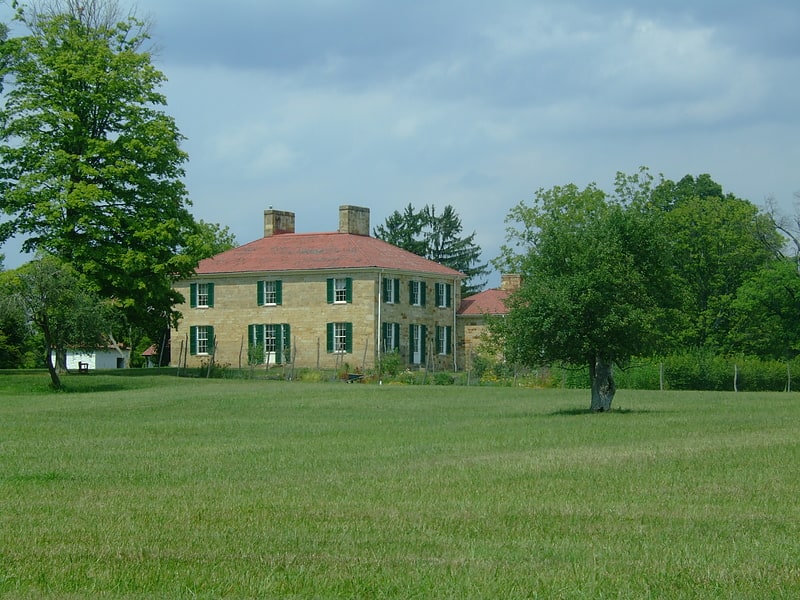
Tourist attraction in Chillicothe, Ohio. The Adena Mansion is a historic house museum in Chillicothe, Ohio. It was built for Thomas Worthington by Benjamin Latrobe, and was completed in 1807. The house is located on a hilltop west of downtown Chillicothe. The property surrounding the mansion included the location of the first mound found to belong to the Adena culture and thus the Adena mansion is the namesake for the Adena people. The state coat of arms is thought to depict the view of Mount Logan from the Adena property. The Adena Mansion is open to visitors for a small fee.[1]
Address: 847 Adena Rd, 45601-1372 Chillicothe
Pickaway-Ross Career & Technology Center
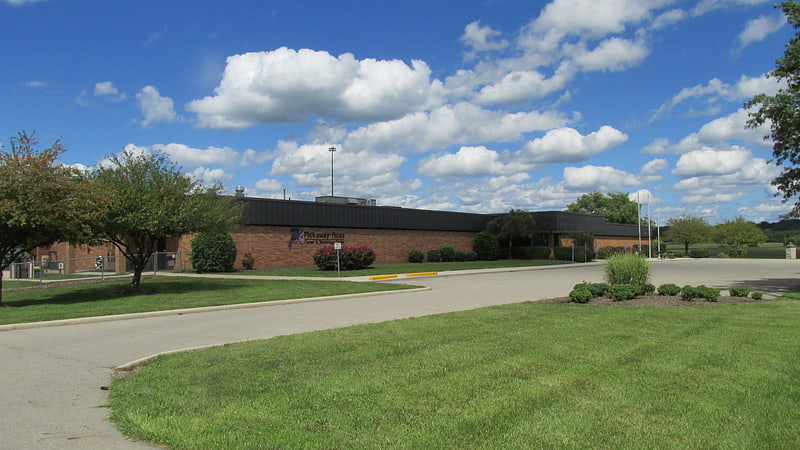
Pickaway-Ross Career & Technology Center is a vocational-technical school serving Pickaway and Ross counties in Ohio. The school is located north of Chillicothe, Ohio and is governed by the Pickaway-Ross County Joint Vocational School District.
Founded in 1974, Pickaway-Ross offers 20 high school tech-prep programs to students from 10 high schools in Ross and Pickaway counties. High school students attend Pickaway-Ross their junior and senior years, and can earn a Career Passport in addition to a diploma from their home schools. Six hundred students attend Pickaway-Ross's main campus, and another 1,500 students attend off-campus (or satellite) programs housed in affiliated high schools.
School districts affiliated with Pickaway-Ross include: Adena, Chillicothe, Huntington, Paint Valley, Southeastern, Unioto, and Zane Trace in Ross County, and Circleville, Logan Elm and Westfall in Pickaway County.
Pickaway-Ross also has an Adult Education Division, providing programs in skilled trades, public safety, medical services fields and others. That division also provides training and consulting services to local businesses and industries.[2]
Yoctangee Park
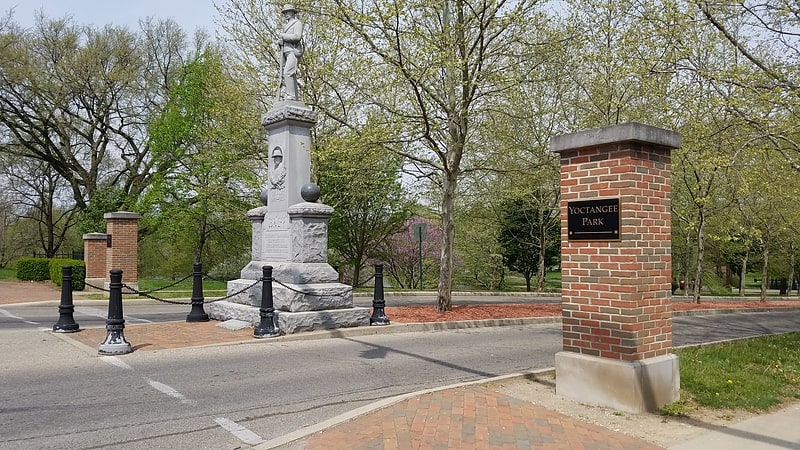
Park in Chillicothe, Ohio. Yoctangee Park is a public park in Chillicothe, Ohio, adjacent to the Historic First Capital District. City Park was the official name of the park from its establishment in 1875 until it was changed to Yoctangee Park sometime in the 1890s by William H. Hunter.
The name Yoctangee is a Native American word for "paint", a reference to the skin and clothing pigments of the culture native to the area.[3]
Grandview Cemetery
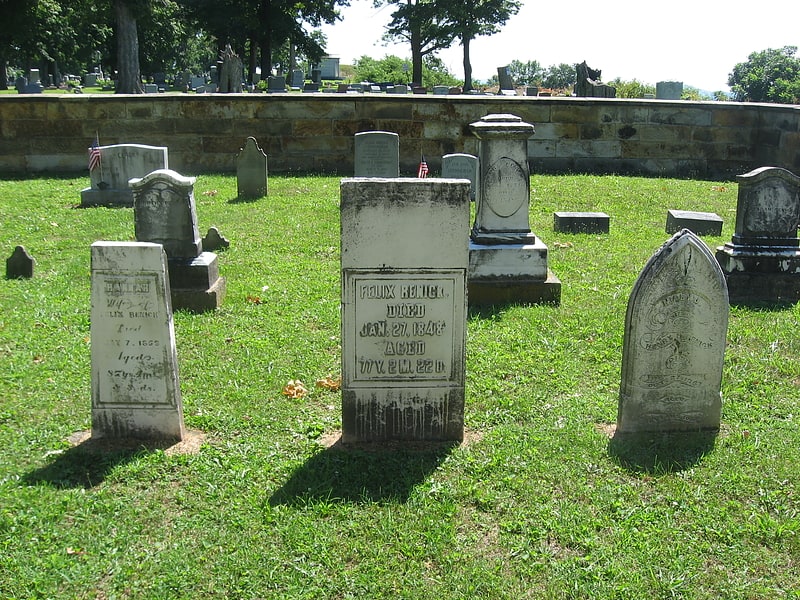
Cemetery in Chillicothe, Ohio. Grandview Cemetery is a cemetery in Chillicothe, Ohio.[4]
Hopewell Culture National Historical Park

National park in Ross County, Ohio. Hopewell Culture National Historical Park is a United States national historical park with earthworks and burial mounds from the Hopewell culture, indigenous peoples who flourished from about 200 BC to AD 500. The park is composed of six separate sites in Ross County, Ohio, including the former Mound City Group National Monument. The park includes archaeological resources of the Hopewell culture. It is administered by the United States Department of the Interior's National Park Service.
In 2008, the Department of the Interior included Hopewell Culture National Historical Park as part of the Hopewell Ceremonial Earthworks, one of 14 sites on its tentative list from which the United States makes nominations for the UNESCO World Heritage Sites.[5]
Address: 16062 State Route 104, Chillicothe
Ohio University – Chillicothe

University in Chillicothe, Ohio. Ohio University – Chillicothe is a satellite campus of Ohio University in Chillicothe, Ohio. Founded in 1946, OHIO Chillicothe campus is the first of Ohio University's regional campuses and the first regional campus in the state. It is located 45 miles south of the state capital of Columbus. As of 2019, it has an enrollment of approximately 1,500 students.
The campus location and the long-time membership of the Ross County region allows OHIO Chillicothe to draw a unique mix of both traditional college students, young adults ages 18–22 who begin college directly out of high school, and "new traditionals," adults who are pursuing a degree later in life, often after many years in of work experience. In addition, the campus offers a wide variety of course times and schedules, to allow students to take classes when at their own convenience. The campus practices open admissions.
The oldest of the five regional campuses of Ohio University and the first regional campus in the state, OHIO Chillicothe opened as a regional campus in September 1946 to help eliminate post–World War II overcrowding on the university's main campus. The school began with 281 students, 70 percent of which were armed services veterans. Beginning with night courses at Chillicothe High School, OHIO Chillicothe started daytime classes in September 1960 at Chillicothe's First Presbyterian Church. The school moved to its current location on University Hill on the western side of the city in September 1966 with the completion of Bennett Hall.
OHIO Chillicothe offers thirteen associate degrees and eight four-year bachelor's degrees. In addition, a variety of continuing education and tech prep courses are offered by OHIO Chillicothe. There are over thirty full-time faculty members and more than seventy adjunct faculty.
The main campus of Ohio University is located in Athens, Ohio. More than 5,500 students attend Ohio University's five regional campuses. The other campuses include OHIO Eastern (St. Clairsville), OHIO Zanesville, OHIO Lancaster, and OHIO Southern (Ironton).[6]
Address: 101 University Dr, Chillicothe
Vanmeter Church Street House
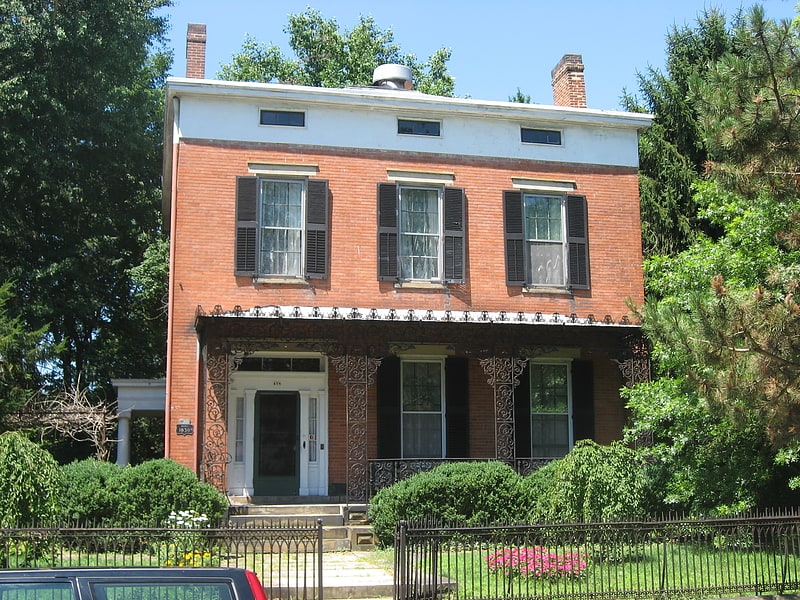
Building in Chillicothe. The Vanmeter Church Street House is a historic house located along Church Street in Chillicothe, Ohio, United States. Built in 1848 in the Greek Revival style of architecture, it was erected by farmer William H. Thompson. Just eight years after its completion, the house was bought by Whig Party politician John I. Vanmeter, a Virginia native who had lived in Ross County for thirty years. After serving in both the Ohio House of Representatives and the Ohio Senate during the 1830s, Vanmeter served a single term in the United States House of Representatives from 1843 to 1845.
Vanmeter's house is a two-and-a-half story brick building located within a neighborhood of well-preserved nineteenth-century houses. Built of brick laid in a stretcher bond, and covered with a metal roof, it has been ranked as one of the area's best Greek Revival structures. Upon his death, Vanmeter bequeathed his house to younger family members; in the late 1970s, it was still owned by Vanmeters.
In 1979, the Vanmeter Church Street House was listed on the National Register of Historic Places, along with two associated outbuildings. It qualified for inclusion on the Register both because of its place in local history and because of its well-preserved historic Greek Revival architecture.[7]
Canal Warehouse
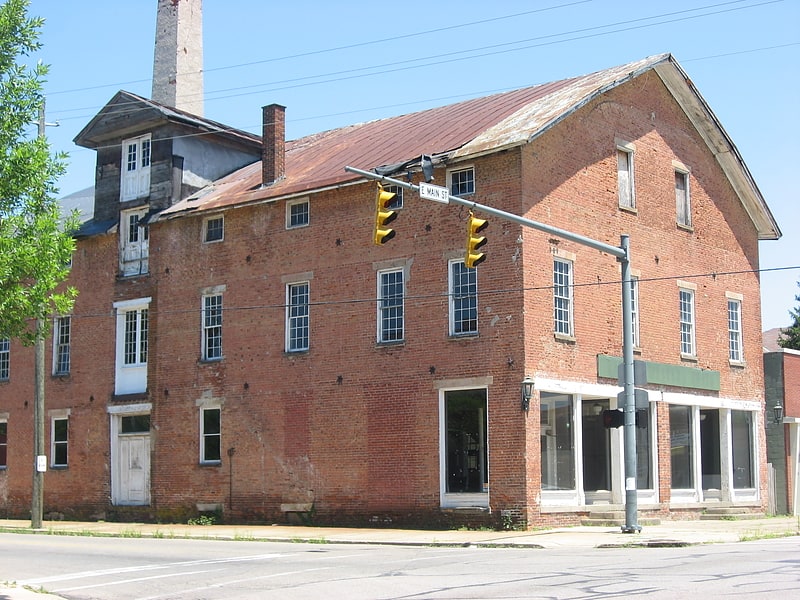
The Canal Warehouse is a historic warehouse at the intersection of Main and Mulberry Streets in downtown Chillicothe, Ohio, United States. Built in 1830, along the Ohio and Erie Canal, this three-story brick building is an ornate gabled structure with large dormers set into both sides of the main roof. These dormers served a purpose far different from decoration: their windows connect with first-floor doors to enable longshoremen easily to move goods into or out of the third floor. On the ground level, individuals can enter the warehouse through either of two recessed doorways; three stone steps climb from the sidewalk to each doorway.
After it ceased to operate as a canalside warehouse, the building was converted into a clubhouse for the local post of the Veterans of Foreign Wars. Today, the warehouse has been recognized as a leading example of canal-related architecture; few warehouses built for the Ohio and Erie Canal survive in comparable condition. In recognition of its place in local transportation history, the Canal Warehouse was listed on the National Register of Historic Places in 1974. Additionally, it lies within the boundaries of the Chillicothe Business District, a historic district that was added to the National Register in 1979.[8]
Mountain House

The Mountain House is a historic Gothic Revival house in western Chillicothe, Ohio, United States. It was built by German immigrant Oscar Janssen in 1852, sitting atop a bluff above the Scioto River and the rest of the city of Chillicothe; its location and architectural style were intended to resemble that of castles overlooking the Rhine in his homeland. Janssen surrounded his house with vineyards, a winery, and a beer garden; because of the house's location on the edge of a steep hillside, he terraced the hillside before developing it. After Janssen's lifetime, the Mountain House passed into the hands of designer and papermaker Dard Hunter. Purchasing the house in 1919, Hunter converted it into a production center for his handmade paper and hand-carven type. Here he produced a wide range of books, publishing them under the banner of the Mountain House Press, and gradually he built a worldwide reputation.
The two-story Mountain House mixes various architectural styles and materials. Although it is primarily a Gothic Revival structure, with details such as Gothic arches for windows and doors, it also includes a significant number of Romanesque Revival elements. Its brick walls rest on a stone foundation, and the interior may be accessed through large wooden doors.
In 1978, the Mountain House was listed on the National Register of Historic Places. It qualified for this distinction both because of its well-preserved historic architecture and because of its connection to Hunter, who was seen as a significant person in local history. Today, the house remains in use as the offices of the Mountain House Press.[9]
Tanglewood

Tanglewood is a historic house on the western side of Chillicothe, Ohio, United States. Built in 1850, it features a combination of the Greek Revival and Italianate styles of architecture, and it is one of the best preserved examples of the rare "monitor" style of residential design.
A Catholic clergyman, John McClean, arranged for the house to be built; however, he sold it to Richard Douglas, a local lawyer, before construction was complete. Douglas owned the property little longer than did McClean, dying soon after it was finished. The house's most prominent resident was William Edwin Safford, who lived there as a boy; growing to adulthood, he developed a strong reputation as a leading naturalist in the islands of the South Pacific Ocean, and he was later appointed to be the first Vice-Governor of Guam after the United States conquered the island in 1898.
Built of brick on a stone foundation, it is covered with a roof of asphalt, and it features various other elements of brick and iron. Tanglewood is an elaborate two-and-one-half-story house with many fine Greek Revival elements. Among its details are multiple pillared porches featuring capitals of the Ionic order, an ornate frieze above the windows, and some elements of the Italianate style that was only just beginning to come into popularity in the middle of the nineteenth century.
In 1979, Tanglewood was listed on the National Register of Historic Places because of its well-preserved historic architecture. It is one of at least two Ohio monitor houses that is listed on the Register, along with one in the village of St. Paris that is known simply as the "Monitor House."[10]
Seip House
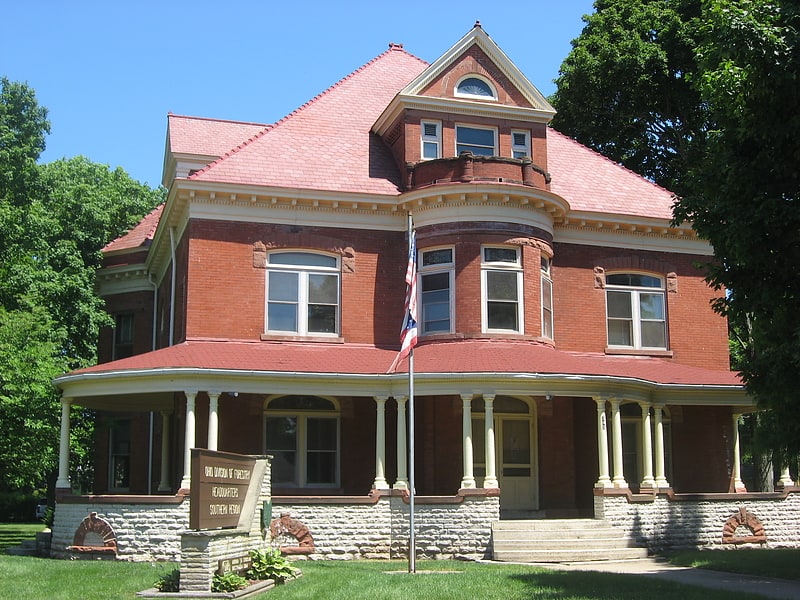
Building in Chillicothe. The Seip House is a historic building on the west side of Chillicothe, Ohio, United States. Built in 1895, it is among the city's grandest houses.
Born in Germany in the late 1810s, Charles Seip was a butcher who settled in the United States in 1845. Soon after crossing the Atlantic, Seip took up residence in Chillicothe; he soon began operating a butcher shop on Allen Avenue, married, and became prosperous. As his business grew, Seip expanded into downtown premises and began to purchase farms in the Chillicothe vicinity in order to supply more animals for his business.
By the 1890s, Seip's son John had persuaded his father to erect a large house on the site of his original butcher shop. The resulting building took four years to complete, being started in 1895 and completed in 1898. A two-and-a-half story building, designed by John Cook, it is a brick building that sits on a sandstone foundation; its roof, covered with slates, is a hip roof that rises to the center of the house.
At his death in 1902, Seip owned some of the leading properties in Ross County. His house was one of the most prominent Queen Anne homes in Chillicothe, and he owned seven different farms in the region. Since that time, the house has changed hands; in 1955, the Ohio Department of Natural Resources purchased the house and converted it into offices for its regional forestry headquarters. In recognition of its historic architecture, the house was listed on the National Register of Historic Places in 1981.[11]